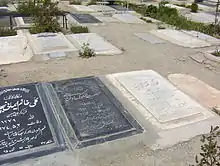Esmat Dowlatshahi
Esmat Dowlatshahi (Persian: عصمت دولتشاهی; 1904[1] – 25 July 1995) was an Iranian royal and the fourth and last wife of Reza Shah.
| Esmat Dowlatshahi | |
|---|---|
 | |
| Born | 1904 Tehran, Iran |
| Died | 25 July 1995 (aged 90–91) Tehran, Iran |
| Burial | Behesht-e Zahra cemetery, Tehran |
| Spouse | Reza Shah (m. 1923 – died 1944) |
| Issue | Prince Abdul Reza Prince Ahmad Reza Prince Mahmoud Reza Princess Fatimeh Prince Hamid Reza |
| House | Qajar dynasty (by birth) Pahlavi dynasty (by marriage) |
| Father | Prince Gholam Ali Mirza Dowlatshahi |
| Mother | Mobtahej Od-dowlah Morad |
Early life
Dowlatshahi was born in 1904.[2][3] She was a member of the Qajar dynasty.[4] Her parents were cousins.[4] Her father was Gholam Ali Mirza "Mojalal Dowleh" Dowlatshahi (1878–1934).[5] Her mother was Mobtahedj-od-Dowleh, daughter of Ebtehadj Saltaneh and Abou Nasr Mirza "Hessam Saltaneh II".[4] Her paternal grandfather was Hessam-Saltaneh I.[4] She had two brothers and one sister.[4] Mehrangiz Dowlatshahi, member of the Majlis and Iranian ambassador, was her cousin.[6]
Marriage

Princess Esmat Dowlatshahi and Reza Shah wed in 1923.[6][7] She was his fourth, last and favourite wife.[8][9] Reza Shah was the minister of war when they married.[6] From this marriage five children were born: Abdul Reza, Ahmad Reza, Mahmoud Reza, Fatimeh and Hamid Reza Pahlavi.[10] When Dowlatshahi's husband became Shah of Iran in 1925, she became empress consort,[3] which she held until 1941 when her husband was deposed.
Dowlatshahi and Reza Shah lived in the Marble palace in Tehran with their children.[8] She accompanied her husband to Mauritius who exiled there in September 1941, and returned to Iran after a few months.[11]
Later life and death
Dowlatshahi stayed in Iran after the 1979 Islamic Revolution.[11] She died on 25 July 1995.[12] She was buried in the Behesht-e Zahra cemetery, Tehran.[13]
References
- "خاطرات عصمتالملوك دولتشاهی آخرین همسر رضاخان". سیمرغ (in Persian). Retrieved 16 June 2020.
- "Esmat Dowlatshahi". GeneaNet. Archived from the original on 1 October 2013. Retrieved 25 July 2013.
- "Esmat Dowlatshahi – (1904 – 1995)". A Bit of History. Retrieved 26 July 2013.
- "Dowlatshahi-Qajar (Kadjar)". Qajar Pages. Archived from the original on 20 November 2013. Retrieved 26 July 2013.
- "Dowlatshahi family". Qajar Pages. Archived from the original on 23 February 2013. Retrieved 19 July 2013.
- Camron Michael Amin (1 December 2002). The Making of the Modern Iranian Woman: Gender, State Policy, and Popular Culture, 1865-1946. University Press of Florida. p. 115. ISBN 978-0-8130-3126-2.
- Cyrus Ghani (6 January 2001). Iran and the Rise of the Reza Shah: From Qajar Collapse to Pahlavi Power. I.B.Tauris. p. 425. ISBN 978-1-86064-629-4.
- Diana Childress (2011). Equal Rights Is Our Minimum Demand: The Women's Rights Movement in Iran 2005. Twenty-First Century Books. p. 40. ISBN 978-0-7613-7273-8.
- "Iranian Princess Fatemeh Pahlavi". Beaver Country Times. London. 2 June 1987. Retrieved 24 November 2013.
- "The Qajars (Kadjars) and the Pahlavis". Qajar Pages. Archived from the original on 28 July 2012. Retrieved 19 July 2013.
- Mehdi Jangravi. "Reza Shah's Wives". Institute for Iranian Studies. Retrieved 19 July 2013.
- "Reza Shah Pahlavi". Iran Chamber Society. Retrieved 19 July 2013.
- "Behesht-e Zahra Cemetery". Harmsen. Archived from the original on 2 October 2013. Retrieved 1 August 2013.